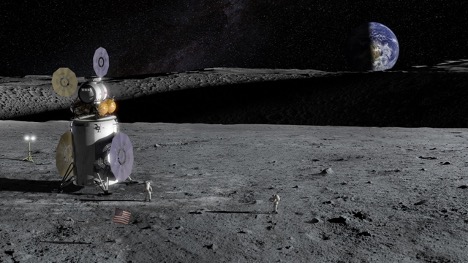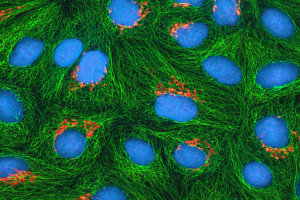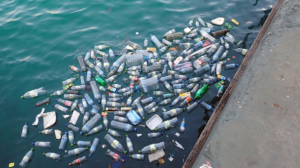
Figure 1: NASA’s Artemis program has the goal of putting the next man and first woman on the moon. A team of researchers believe they have come up with definitive proof that there could be much more water and ice on the moon than was earlier speculated.
Source: Wikimedia Commons
The moon has been an object of great fascination for humankind. Space-bound astronauts and scientists on Earth have long yearned to flip the veil of mystery and study the moon through scientific methods. Today, one of the biggest aims of space exploration is the detection of water, and its various forms, on other celestial bodies. With such a discovery, there would be hope for human relocation. While water has been discovered on Mercury and Ceres, Ceres is beyond Mars and Mercury is too hot for human relocation to be conceivable. Thus, there is great interest in proving the existence of water on the moon, a reachable, habitable body (Dunbar, 2017).
Reports of lunar water have been recorded by the Chandraayan-1 spacecraft through its Moon Mineralogy Mapper (M3). The M3 reports, however, are inconclusive because technical deficiencies at that time made it impossible to distinguish hydroxyl chemical groups from water. It was afterwards determined from M3 data, though, that lunar water would most likely occur in shaded regions of the moon (Anand, 2010). This has spurred further investigation of lunar water.
Recently, a team of scientists led by Paul Hayne, an assistant professor in the laboratory of Atmospheric and Space Physics at the University of Colorado Boulder, obtained proof that there might be more lunar water than was previously presumed. (Hayne, Aharonson, & Schörghofer, 2020). This team’s mission was to deduce the surface area occupied by Permanent Shadowed Regions (PSRs). PSRs are dark areas on the moon which do not receive sunlight. The scientists wanted to verify what portion of these PSRs have a surface temperature of 110K or less and evaluate the latitude at which water-ice is likely to form (Hayne et al., 2020).
Hayne and his team examined PSRs on the polar regions of the moon since water would be more protected there from the sun’s rays. They found that beyond 80 degrees latitude, subzero temperatures, suitable for the existence of water-ice, become more prevalent. Upon investigation, they found that within the PSRs, there exist areas, known as ‘cold traps’, where the frigid temperatures allow volatiles, such as water, to remain stable (Watson, Murray, & Brown, 1961). Small scale shadows photographed by the Lunar Reconnaissance Orbiter Camera Narrow Angle Camera (LROC-NAC) also hinted at the presence of further ‘micro-cold traps’ inside the PSRs, which substantially increases the potential cold-trapping surface area of the moon. (Hayne et al., 2020)
The team set out to conclusively prove not just the existence of cold-traps and micro-cold traps on the moon, but also their extent. Through the aid of the LROC-NAC oblique view camera, they concluded that the south polar region is dominated by several craters, signaling the existence of more cold traps as large as 1 km to 10 km in diameter. They examined photos taken from the Yutu Rover and determined that there exist PSRs as small as 1 cm to 10 cm in diameter as well. (Hayne et al., 2020)
They found that the southern hemisphere has a greater number of cold-traps and micro-cold traps overall (nearly 23, 000 km2) while the northern hemisphere only has a smaller amount cold-traps and micro-cold traps that only span 17,000 km2 in total (Hayne et al., 2020). The cumulative area of the cold-traps and micro-cold traps is the same size as Switzerland, with the most numerous cold traps only 1 cm in scale. This is quite different from what was previously estimated: 13,000 km2 in the Southern Hemisphere and 5,300 km2 in the Northern hemisphere (Williams et al., 2019, p. 2512).
Although water-ice had previously been presumed to exist on the lunar surface, Hayne’s study of cold traps and PSRs has profound implications. For one, cold traps guarantee that trapped water may stay present for a long time. In Hayne’s words: “[I]f water gets in there, it is not going anywhere for a billion years.” By confirming the existence of more cold traps, Hayne and his team have helped set in motion what could be a new era of lunar exploration, and even settlement – one that could commence with the NASA Artemis program. The invaluable water-ice could even be used to fuel rockets and rovers, offsetting the expenses of extraterrestrial exploration. Soon, as we gaze to the night sky, we may yet see lunar encampments, a giant leap forward in the advancement of human space exploration.
References
Anand, M. (2010). Lunar Water: A Brief Review. Earth, Moon, and Planets,107(1), 65-73. doi:10.1007/s11038-010-9377-9
Dunbar, B. (2017). Water Ice on Mercury. NASA. https://www.nasa.gov/image-feature/water-ice-on-mercury/
Dunbar, B. (2017). Where is the Ice on Ceres? New NASA Dawn Findings. NASA. https://www.nasa.gov/feature/jpl/where-is-the-ice-on-ceres-new-nasa-dawn-findings/
Hayne, P. O., Aharonson, O., & Schörghofer, N. (2020, October 26). Micro cold traps on the Moon. Nature Astronomy. https://www.nature.com/articles/s41550-020-1198-9?error=cookies_not_supported&code=7381e05d-7ebb-4162-a7af-2cafc60fea7a
Watson, K., Murray, B., & Brown, H. (1961). The Behavior of Volatiles on the Lunar Surface (VOLUME 66. No. 9). Division of Geological Sciences California Institute of Technology. https://authors.library.caltech.edu/51509/1/jgr1929.pdf
Williams, J. ‐. P., Greenhagen, B. T., Paige, D. A., Schorghofer, N., Sefton‐Nash, E., Hayne, P. O., Lucey, P. G., Siegler, M. A., & Aye, K. M. (2019). Seasonal Polar Temperatures on the Moon. Journal of Geophysical Research: Planets, 124(10), 2505–2521. https://doi.org/10.1029/2019je006028
Related Posts
Acoustic Reporter Genes: The Newest Breakthrough in Cell Visualization
Figure: A fluorescent protein is expressed in human epithelial cells...
Read MoreGenomic Research For All Humanity
From DNA to Life. (Source: Wikimedia Commons, William Crochot) Our...
Read MoreBio-renewable Alternative to Polyethylene Terephthalate (PET)
The pliability and low-cost of synthetic thermoplastics have rendered them...
Read MoreCollins Kariuki



